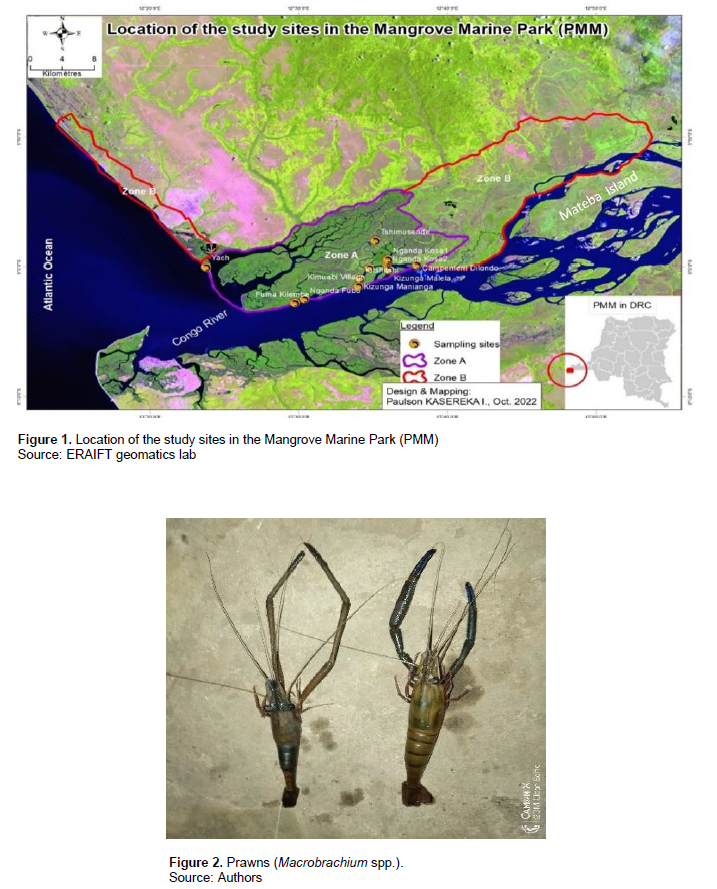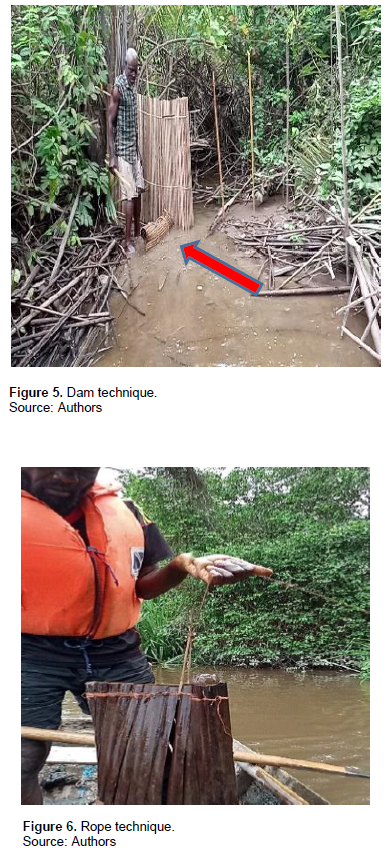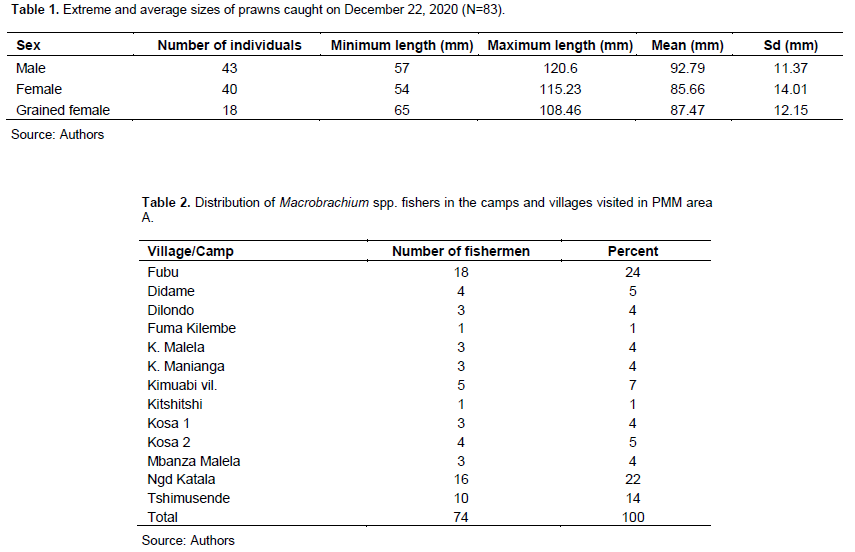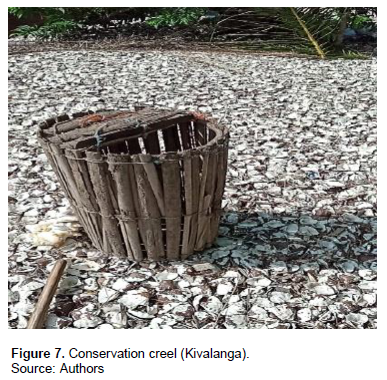Full Length Research Paper
ABSTRACT
This study provides information on the environment, modes of access and exploitation of Macrobrachium species, the level of capture, the operators and their organization. The data collected through interviews and direct observations revealed that Macrobrachium spp. are caught on the banks of the Congo River near the islands of Kimuabi, Malela and Mateba in Zones A and B of the Mangrove Marine Park (PMM). This fishery is carried out individually by a mainly male population throughout the year using a cylindrical creel baited with palm nuts and dead crabs. The free access to the fishery and the poor knowledge of the factors contributing to the existence of Macrobrachium spp. among some fishermen lead them to exert considerable pressure on this resource. This results in the capture of smaller and immature individuals of about 57 and 54 mm, respectively for males and females. It is necessary to deepen this study on the biological, ecological and economic aspects of this resource by involving all the stakeholders concerned by this exploitation in view of a participatory co-management where the fishermen will be particularly concerned.
Key words: Macrobrachium, Mangrove Marine Park, D.R. Congo.
INTRODUCTION
The Congolese dense rainforests contain not only rare timber species, but also privileged habitats for wildlife and aquatic fauna. Being one of the countries of the Congo Basin with numerous rivers and lakes, D.R. Congo has significant potential fisheries estimated to about 700,000 t/year (MEDD, 2019). Apart from vertebrates, its aquatic fauna contains 1596 species of aquatic invertebrates, among which 1423 of freshwater and 183 of marine species (MECN-DD, 2016). Among the aquatic edible invertebrates are freshwater crustaceans including giant freshwater prawns of the Macrobrachium genus, which is a very important group because they are traded locally and internationally (Gangbe et al., 2016). Often referred to as Kosa in Solongo, the Macrobrachium spp. prawns are excessively fished in Congo River estuary, which is an integral part of the Mangrove Marine Park (PMM) in Muanda. It is one of the nation's wetlands of international consideration listed in the Ramsar Convention of January 18, 1996 (Ramsar, Iran, 1971) (https://mangrovec congo.net accessed on April 25, 2018). Actually, the PMM is not only a place par excellence of the reproduction of fish (344 species, pers. Com. P. N’Lemvo) and other halieutic species; but also that of refuge for shrimps and fishes during high tide. However, anthropogenic activities, such as oil extraction, illegal fishing, woods exploitation and rowing agriculture on burnt lands exert considerable pressure on this park. The result is water quality and habitats degradation on which these halieutic species depend. The threats to this aquatic ecosystem have become an issue for the national scientific community (Muyaya et al., 2017; Kisangala et al., 2019; Mvambi et al., 2018). However, issues related to the sustainable management of fisheries resources in general and to the giant freshwater prawns Macrobrachium spp. more particularly in this ecosystem, have been the least studied, despite the strong fishing pressure these species are subject to. Hence, the importance of this preliminary study which aims to identify the fishing sites, the mode of access and exploitation, the exploiting populations, including their social organization in order to come up with perspectives for further studies.
MATERIALS AND METHODS
Study zone
This preliminary study was carried out in the fully protected Zone A of the Mangrove Marine Park (PMM), precisely near two villages, Kimuabi and Malela, located in Congo River estuary in Malela grouping, Sector of Assolongo, Territory of Moanda, Bas-fleuve District, Province of Central Kongo in Democratic Republic of Congo. It is located between 5° 59' - 6°2' South latitude and 12°29' - 12° 37' East longitude (Figure 1). These sites are characterized by the presence of mangroves dominated by Rhizophora species. There are also other species, such as Raphia sese De Wild and Pandanus species located at the national border with Angola. The overwhelming majority of the population is from the "Assolongo" tribe that is originally from both borders of the two countries, estimated to 4,967 inhabitants in 2020 (Assolongo Sector Office, 2020).
Data collection
Data were collected from October 24 to November 17 and from December 3 to December 25, 2020, the period of the strong fishing activity of these species. Two villages: Kimuabi and Mbanza Malela; and 11 fishermen's camps, namely, Nganda Fubu, Nganda Fumakilembe,Nganda Didame, Nganda Kitshitshi, Kizunga Manianga, Kizunga Malela, Nganda Tshimusende, Nganda Katala, Nganda Kosa 1, Nganda Kosa 2 and Nganda, were involved in this survey.
Data collection consisted of interviews and direct observations. The interviews were conducted in French and in Lingala, which one of the national languages, with about forty (40) people among whom 23 active fishermen of the study area.
Interview guides were elaborated in order to get information on the fishing sites, the fishing period, the actual fishermen, the fishermen’s social organization, the access mode, and the fishing techniques used. It was through those interviews and participatory observations that we learnt about the tools and techniques of fishing shrimps. The shape of these tools was described and their size was taken using a tape measure. Eighty-three (83) specimens of Macrobrachium spp. were considered from the catch lot of a fisherman in order to get an idea about the size of the prawns caught which was measured using calipers to the nearest 0.01 mm. (Figure 2)

Data processing
The data on the overall population of fishermen and on the prawns size were processed using Word processor and Excel 2016, and presented through tables for analysis and interpretation.
RESULTS
Location of the fishery
According to the respondents, the Macrobrachium spp. prawns, referred to as Kosa in the local language, are fished on the banks of the Congo River and in its arms locally called Muila, near the islands of Kimuabi, Malela and Mateba located in the protected Zones A and B of the Mangrove Marine Park. The fishermen sometimes enter the flooded forest in order to place their capture equipment.
Type of fishing
The Macrobrachium spp. prawns are caught individually with a cylindrical creel, locally called Kinkasa, baited with palm nuts and dead crabs. It is made of dry branches of Raphia sese found in its habitat. Its height varies from 60 to 80 cm with a diameter varying from 20 to 40 cm. The upper base of the creel is closed, while leaving a small opening of approximately 10 cm in the shape of funnel being used as door of entry for the shrimps (Figure 3). Inside the creel, there are two spaces separated by a partition with a funnel-shaped opening of the same size serving as the entrance door. The creel is narrowed and partially closed at the lower base, and there is a small opening of about 15 cm to recuperate the captured prawns. During the installation of the creel, this small opening at the lower base is closed either by means of a plastic bottle with a capacity of 50 cl filled with water, or a piece of flip-flop sole to prevent any escape of the captured prawns. The number of pots used by every fisherman varies between 20 and 400 pots. Given the benthic nature of this type of prawns studied, the creel used for capture is used in 3 different techniques depending on the depth of the water, namely: the techniques of pitting, rope, and the dam technique.
Pitting technique
This technique consists of placing the creel perpendicular to the water flow on the bank in a shallow area (less than one meter) during low tide. The creel is supported by a thin stake of less than a meter, referred to as Lunama, which is firmly embedded in the muddy bottom (Figure 4). The control of the creel is done every 24 h, day and night, during low tide by means of a non-motorized canoe propelled by a paddle. After 1 or 2 weeks, the fisherman changes and adopts the rope technique.

Rope technique
It consists of immersing the baited creel near the mangroves in places more than a meter deep, sustained by a long rope attached to the stilt root of the mangrove or another plant species so that it is not carried away by the water current. The control operation is carried out at the same time as that of the creel supported by a rod. Like the previous technique, the installation of the creel takes place during low tide. This procedure uses the wet creel capable of reaching the bottom substrate at a depth of more than a meter. In the first and the second techniques, the creel remains in the water for the entire period of the fishery, except in the case of damage that requires its substitute. The same creel can be taken also to other locations if the catching becomes less abundant. This double option technique is much more practiced by young fishermen under 50 years of age, as it is less tedious than the dam technique described subsequently.
Dam technique
Locally referred to as Zimbanza, the dam technique is quite old, and it is practiced in the small water channels, Nzondo, formed by the waters of the Congo River. Contrary to the previous techniques, the dam technique is practiced by experienced fishermen over 50 years old, preferably during the dry season (February, June, July and August). It targets both prawns and fish of all sizes. Here, the capture is done in 4 periods:
(1) During the day when the water level drops, the fisherman proceeds with the preparation of the location by installing stakes on which the mat made of raffia rods will be fixed, based on the width of the channel and on the water level during the high tide to create a dam;
(2) In the evening, at the beginning of the high tide, the fisherman sets the mat leaving a large opening allowing the shrimps and fish to penetrate the mangroves. He places the creel of about 80 cm height stuck against that mat on its external face, while creating an opening between the two and he makes sure of blocking all ways through which prawns and fish could escape. After fixing the dam, the fisherman returns home while observing water fluctuation carefully;
(3) At the end of the high tide and (4) before the beginning of the low tide, the fisherman returns to the fishing site in order to close the installed dam completely (Figure 5);
During the low tide when the water level in the forest drops, the fisherman collects shrimps and fish while keeping the dam in place. Then, he collects the shrimps and the small fishes caught in the trap. At the end of the operation, the trap and the mat are uninstalled and brought back home for further use.
Technique of conservation of the captured prawns
The prawns caught are kept alive in a creel locally called Kivalanga or kompa in Solongo. It is made of the same materials as the catching net described earlier, with the only difference that the latter is larger, having at least 80 cm height and 40 cm of diameter. This type of creel does not have a partition. The lower base of the creel is completely closed while the upper base is partially closed, leaving an opening through which the prawns entered and are recuperated. The creel can contain about 100 prawns fed either with palm nuts and/or dead crabs. After introducing the prawns and closing the entrance opening with a nylon thread, the creel is loaded with a series of oyster shells, and is sustained by a long rope attached either to the stilt root of the mangrove, or to a heavy metal near the fishing site or the village and then immersed in water of more than one meter deep (Figure 6). It is this device which helps to keep the prawns alive in the water during the entire fishing period while waiting for potential buyers or the shipping toward the marketing place.

Fishing period
Prawns fishing in this area are carried out throughout the year, regardless of the reproductive period of this species and the size of the individuals caught.
Table 1 presents the extreme and average sizes of prawns observed in the batch of catches taken on board by a fisherman from Kimuabi village on 22 December 2020.
Daily yield of the Macrobrachium spp. fishery
The overall quantity of Macrobrachium spp. caught depends on two things: the number of traps that a fisherman has, and the time of the year. According to the fishermen, the daily quantity of Macrobrachium spp. caught is around 3 kg for 50 traps used during the rainy season. This quantity decreases during the dry season. According to one of the fishermen, compared to the 90s, the quantity obtained at present is smaller because they managed to catch more than 10 kg for 9 traps used. The reasons for this decrease in catches over the last 30 years are, among others, the increase in the number of fishermen in their fishing area on the one hand, and the lack of observation of rest periods to help the prawns to reproduce and multiply in number. Due probably to ignorance, some fishermen, however, attribute this decrease to divine will.
Macrobrachium spp. prawns fishermen
This fishery is practiced by a cosmopolitan male population, the majority of whom are from Assolongo and Kongo tribes, originally from the villages of Katala and Kibamba which are located in Zone B of the MMP. The interviews showed 74 fishermen specializing in Kosa fishing in the villages and camps we visited in Kimuabi and Malela sites. The majority of these fishermen (24%) were located in Nganda Fubu, followed by Nganda Katala (22%) and Tshimusende (14%) (Table 2). It was reported also that some fishermen do migrate toward other sites such as Katala, Kibamba and the island villages of Angola in case there is a decrease in catch.

Access to fishing
Access to fishing is free because, according to the chief of the Malela grouping, water is a common property without master. However, non-native fishermen pay a fee as right of residence to the village, or to the camp chiefs if they wish to live there in order to carry out fishing activities; the same principle applies to those who request a piece of land to farm. At the village level, this right of residence is valued at the price of two cases of national beer equivalent to $25 ($1 for 2,000 Congolese francs) and 10 L of palm wine that cost $5. At the camp level, on the other hand, the right of residence is fixed at 3 bottles and a case of national beer. In addition, every fisherman pays 5000 FC ($2.5) every year as annual tax to the chief of Assolongo sector for the use of a canoe.
Social organization
Most of the fishermen interviewed declared that they do not belong to any association simply because they do not trust their association leaders. However, they are organized informally using the "tontine" system, in which a determined number of fishermen, consisting of groups of friends or family members, commit themselves to paying each one of them a well-fixed quantity of prawns (e.g. 10 kg of prawns) at a regular frequency (e.g. at the end of each week). Based on this rotary tontine rule once set up, one of the participants receives the prawns collected from the other fishermen. This rotary system helps the fishermen to get a big amount of money in a short period of time in order to carry out certain costly projects. In Kimuabi, for example, there is only one such association of located in Fubu camp, known as Association of Fubu Prawns fishers at Kimuabi (APECREFUKI/ASBL). This association was founded in 2017 thanks to the FAO agents’ advice. At present, it has 32 members including 23 fishermen and 9 fishmongers.
DISCUSSION
It came out of this study that the Macrobrachium spp. capture is done by means of creels baited with palm nuts and dead crabs. The creel technique has been reported by several authors among whom Central and West African peoples (Bahuchet and Rameau, 2016; Akonkwa et al., 2017; Attingli et al., 2017; Allagbe et al., 2020). Factors explaining the daily use of the creel include: the availability of the equipment, the easy conditions of its acquisition and the mastery of this fishing tool (Adou et al., 2021).
This fishing tool used throughout the year has a non-selective character which results in the capture of not only male and female individuals whose average size is, respectively about 100 and 86 mm, but also of smaller and immature individuals varying between 57 and 54 mm, respectively for males and females. However, Akonkwa et al. (2017) and Attingli et al. (2017) reported that the creel is among the least selective fishing tools in that it is at the basis of the decline in fishery resources. This constitutes a potential danger for the future of these particular species.
The practice of fishing during the spawning period does not pose any problem to the fish stock provided that the latter is in good conditions and that quota is respected (Ethic Ocean, 2018). In the Congolese context, where the exploitable potential of some species, such as the Macrobrachium spp. is unknown, fishing during the spawning season should be made an issue.
The assumption about attributing the reduction of catches to the divine will was also made by Micha (2019) among Lokele fishermen living in the Yangambi Biosphere Reserve. Such a belief is not likely to contribute to a sustainable use and perpetuation of fisheries resources.
The predominance of males in prawns fishing was also observed by Chuku et al. (2021) in Nigeria. That could be explained by the fact that fishing for the Macrobrachium spp. during the day and at night requires a lot of physical effort of setting and checking the creels over a long distance while rowing at the same time to remote fishing zones (Figure 7).

The idea of the PMM water body as a common property without owner urges the fishermen to exploit this resource quite freely without caring about future generations. That is due to the lack of law enforcement and regulations, as well as to the lack of qualified staff at the national level to ensure surveillance. Until now, the nation has been using the old regulations on fishing that was set in 1937 (DRC fishing law). The provisions of this colonial law have not been updated, especially on issue regarding sustainable and responsible fishing.
The tontine system is one of the alternatives to the issue of access to funding to be considered for rural communities in Sub-Saharan Africa (Kadandji, 2021; Sarr and Fall, 2021). However, that does not help the fishermen to invest fully to the height of their needs, nor protect themselves against climatic changes and economic fluctuation. Hence, the need to gather in a formal association in order to benefit from the actions of struggle against poverty and climatic hazards set up by national and international organizations.
CONCLUSION
This study on the fishing of the giant freshwater prawn "Macrobrachium spp." showed that the exploitation of this resource in the PMM is done in an individual and uncontrolled way by a mainly male population using a cylindrical trap baited with palm nuts and dead crabs. This fishing practice is not sustainable because it does not take into account the reproduction period and the size of the individuals caught. Although fishermen have noted a decrease in the level of their catch over the last 30 years, some of them are unaware of the causes that affect this reduction. Hence, the importance of deepening this study from the biological, ecological and economic point of view of this fishery resource by involving all the stakeholders concerned by this exploitation, in view of a participatory co-management where the shrimp fishermen, primary actors of this exploitation, will be particularly concerned. This is our challenge for the years to come.
CONFLICT OF INTERESTS
The author has not declared any conflict of interests.
REFERENCES
|
Adou YE, Blahoua KG, Yeo K. Konate S, Tiho S (2021). Typologie de la pêche de la rivière Agnéby dans la localité de Dabou (Côte d'Ivoire, Afrique de l'Ouest): Acteurs et engins de pêche. Journal of Applied Biosciences 164(1):16943-16954. |
|
|
Akonkwa B, Ahouansou MS, Nshombo M, Lalèyè P (2017). Caractérisation de la pêche au lac Kivu. European Scientific Journal 13(21):269-292. |
|
|
Allagbe EO, Yabi I, Yabi FB (2020). Caractérisation des activités de pêches dans la Commune de Adjojoun au sud-est du Benin. Agronomie Africaine 32(3):375-388. |
|
|
Attingli AH, Ahouansou Montcho S, Vissin EW, Zinsou LH, Lalèyè PA (2017). Influence des Engins et Techniques de Pêche sur l'Abondance Relative des Espèces dans la Basse Vallée de l'Ouémé au Bénin. African Crop Science Journal 25(1):47-70. |
|
|
Bahuchet S, Rameau P (2016). Quelques engins de pêche en eau douce d'Afrique centrale. Revue d'ethnoécologie 10. |
|
|
Chuku EO, Adotey J, Effah E, Abrokwah S, Adade R, Okyere I, Aheto DW, Kent K, Crawford B (2021). The Estuarine and Mangrove Ecosystem-Based Shellfisheries of West Africa: Spotlighting Women-Led Fisheries Livelihoods. USAID Women Shellfishers and Food Security Project. Coastal Resources Center, Graduate School of Oceanography, University of Rhode Island. Narragansett, RI, USA. 70 p. |
|
|
Ethic Ocean (2018). Guide des espèces à l'usage des professionnels. Available at: |
|
|
Gangbe L, Agadjihouede H, Chikou A, Senouvo P, Mensah G, Laleye P (2016). Biologie et perspectives d'élevage de la crevette géante d'eau douce Macrobrachium vollenhovenii (Herklots, 1857). International Journal of Biological and Chemical Sciences 10(2):573-598. |
|
|
Kadandji A (2021). Les facteurs de la transition du secteur informel vers le secteur formel: Cas des tontines aux coopératives au Cameroun. Journal of Academic Finance 12(2):89-102. |
|
|
Kisangala MM, Kamosi Z, Kafuti S (2019). Evaluation de l'état de la Déforestation de la Forêt du Mayombe par Télédétection de 1990 à 2015 (Province du Kongo Central-R.D. Congo). ACASTI and CEDESURK Online Journal 7(2):102-107. |
|
|
MECN-DD (2016). Stratégie et plan d'action nationaux de la biodiversité (2016-2020), 91 p. Available at: |
|
|
MEDD (2019). Sixième rapport de la République Démocratique du Congo à la convention sur la biodiversité biologique, 414p. Available at: |
|
|
Muyaya Kalambay B, Rudant JP, Lumbuenamo Sinsi R, Muamba Muambanzambi P, Wayawo Mandata A, Konunga Mbotekola G, Collet M (2017). Appréciation du potentiel des images satellitaires Sentinel1 et Sentinel2 pour la cartographie du parc marin des mangroves, en République Démocratique du Congo [Assessment of the potential of satellite imagery Sentinel1 and Sentinel2 for the mapping of the mangrove marine park in the Democratic Republic of Congo]. International Journal of Innovation and Applied Studies 21(3):398-409. |
|
|
Micha JC (2019). Défis dans la conservation des poissons dans les aires protégées du bassin du Congo. La Revue Nature et Faune 32(2):69-74. |
|
|
Sarr NF, Fall M (2021). La promotion de l'empowerment et de l'entrepreneuriat féminin auprès des femmes exclues des politiques sociales et économiques au Sénégal. Revue Organisations et territoires 30(2):31-37. |
|
|
Mvambi NB, Subi MO, Tasi MJP (2018). Ruée vers les ressources halieutiques dans le Parc Marin des Mangroves à Muanda en République Démocratique du Congo. Revue Africaine d'Environnement et d'Agriculture 1(2):21-28. |
|
Copyright © 2024 Author(s) retain the copyright of this article.
This article is published under the terms of the Creative Commons Attribution License 4.0